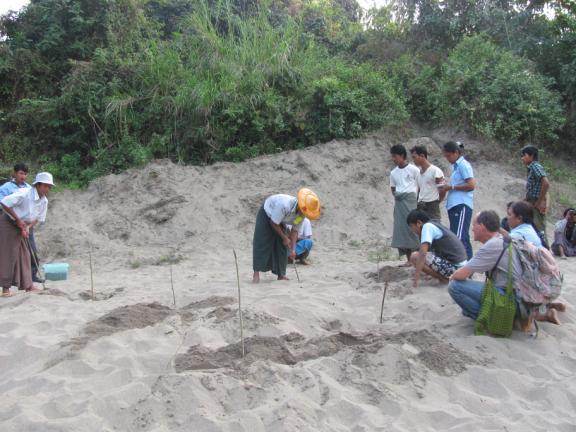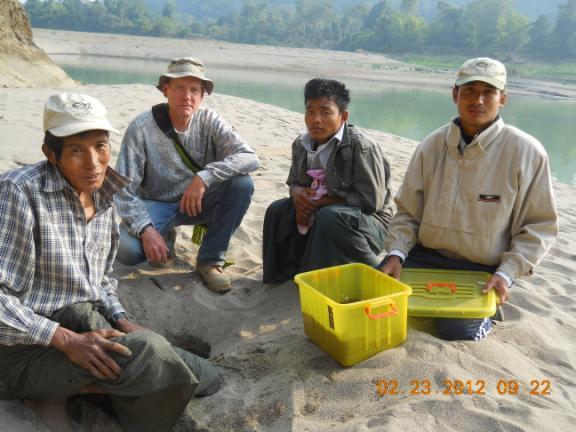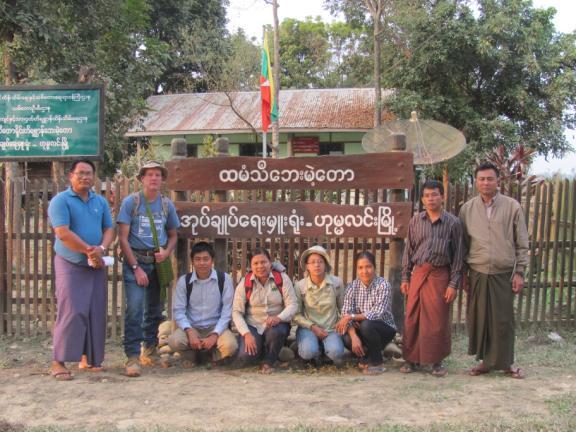Searching for the Burmese Roofed Turtle
by Steve and Kalyar Platt 
 The TSA/WCS Myanmar Program Turtle Team returned this week from a two month expedition up the Chindwin River in northwestern Myanmar. Access to this region by foreigners has long proven difficult owing to security concerns that have recently lessened. The principal objectives of the expedition were to determine if any populations of Burmese roofed turtles (Batagur trivittata) remain along the lower Chindwin River, and investigate local reports of hitherto unknown populations on tributary creeks of the upper river. Despite significant conservation progress, including a highly successful captive-breeding colony and head-starting program, Batagur trivittata is considered one of the most critically endangered turtles in the world with fewer than 10 reproductive females thought to remain in the wild.
The TSA/WCS Myanmar Program Turtle Team returned this week from a two month expedition up the Chindwin River in northwestern Myanmar. Access to this region by foreigners has long proven difficult owing to security concerns that have recently lessened. The principal objectives of the expedition were to determine if any populations of Burmese roofed turtles (Batagur trivittata) remain along the lower Chindwin River, and investigate local reports of hitherto unknown populations on tributary creeks of the upper river. Despite significant conservation progress, including a highly successful captive-breeding colony and head-starting program, Batagur trivittata is considered one of the most critically endangered turtles in the world with fewer than 10 reproductive females thought to remain in the wild.
The Turtle Team boarded a river steamer and departed Monywa in early February. We traveled slowly upstream, making frequent stops at riverside villages to query the locals about the occurrence of these large river turtles. Discouragingly, we found that roofed turtles apparently no longer nest on sandbanks along the lower Chindwin River. However, scattered individuals seem to persist in this stretch of river, occasionally becoming enmeshed in nets set by local fishermen. Because these turtles are imperiled by fishing operations and reproduction is not occurring, follow-up efforts are being planned to bring these animals into captivity to augment the small number of breeding adults in the assurance colonies.
 The Turtle Team continued upriver to the Linpha Village Basecamp where a head-starting facility was established about 5 years ago. Currently, 92 young turtles are being reared at the facility, some for eventual release into a suitably protected area, and others will be transferred to the assurance colony at Lawkanandar Wildlife Sanctuary near the ancient city of Bagan, where about 100 additional young animals are currently maintained. The team also purchased two large fiberglass tanks in Monywa and transported these to the Linpha facility to be used to house the growing turtles.
The Turtle Team continued upriver to the Linpha Village Basecamp where a head-starting facility was established about 5 years ago. Currently, 92 young turtles are being reared at the facility, some for eventual release into a suitably protected area, and others will be transferred to the assurance colony at Lawkanandar Wildlife Sanctuary near the ancient city of Bagan, where about 100 additional young animals are currently maintained. The team also purchased two large fiberglass tanks in Monywa and transported these to the Linpha facility to be used to house the growing turtles.
While at Linpha Basecamp the team assisted Kyaw Moe (project manager) with collecting two clutches of B. trivittata eggs, deposited only hours before on sandbanks near the village. After excavating these nests, the eggs were packed in a sand-filled plastic box for transport back to the head-starting facility, and buried in a nearby sandbank, where they will be allowed to incubate under the watchful eyes of a local beach warden. Each buried clutch is surrounded by a wire mesh fence, and upon emerging from the sand, the hatchlings will be collected and placed in grow-out tanks at the basecamp. After our departure, Kyaw Moe collected several additional clutches and almost 150 eggs are now incubating at the facility.
 From Linpha Village, we proceeded downstream to Htmanthi Wildlife Sanctuary near the riverside town of Homalin. Comprising over 2,000 square kilometers of tropical forest, Htmanthi Wildlife Sanctuary is Myanmar’s third largest protected area. Three creek systems drain the sanctuary and recurring local reports suggested remnant populations of roofed turtles may yet persist in these drainages. We surveyed each creek system in hopes of locating nesting areas, but unfortunately illegal gold mining operations have run roughshod over the area, leaving behind mercury-tainted sediments and heaps of mine tailings, hardly a hospitable environment for nesting turtles. Nonetheless, one or two females apparently continue to nest along these creeks and efforts are currently underway to locate and transport their clutches to the head-starting facility at Linpha.
From Linpha Village, we proceeded downstream to Htmanthi Wildlife Sanctuary near the riverside town of Homalin. Comprising over 2,000 square kilometers of tropical forest, Htmanthi Wildlife Sanctuary is Myanmar’s third largest protected area. Three creek systems drain the sanctuary and recurring local reports suggested remnant populations of roofed turtles may yet persist in these drainages. We surveyed each creek system in hopes of locating nesting areas, but unfortunately illegal gold mining operations have run roughshod over the area, leaving behind mercury-tainted sediments and heaps of mine tailings, hardly a hospitable environment for nesting turtles. Nonetheless, one or two females apparently continue to nest along these creeks and efforts are currently underway to locate and transport their clutches to the head-starting facility at Linpha.
More promisingly, the team visited Nam Thalet Chaung (=Creek), a large tributary on the west bank of the Chindwin near Homalin, and identified a hitherto undocumented population of roofed turtles. The presence of active insurgent groups prevented us from traveling too far upstream. Regardless, we located at least two nesting beaches where according to local villagers, 3 to 5 clutches are deposited every year. A local warden was hired to monitor these beaches and will notify Kyaw Moe when the turtles deposit eggs. Nam Thalet Chaung has been spared the attention of gold miners and remains in a relatively pristine condition. Because of its near-pristine state and proximity to the Myanmar Forest Department field station in Homalin, Nam Thalet Chaung is being evaluated as a possible future release site for head-started turtles.
After completing our survey of Htmanthi Wildlife Sanctuary and Nam Thalet Chaung, the Team went on “walkabout” through the Naga Hills. “Hills” in name only, the Naga Hills are an extremely rugged mountain range along the Indian border of which almost nothing is known regarding its fauna. Once renowned throughout Myanmar as head-hunters, the Naga tribesmen proved gracious hosts and warmly welcomed us into their villages. During this 10 day trek we verified the occurrence of Cuora mouhotii and Cyclemys fusca in the area. These records were of particular importance as the distribution of C. mouhotii in Myanmar is poorly known and few specimens have been observed since the 1930s. Fortunately, neither species seems threatened by human activities. Although widely known for their hunting skills, the indigenous hill tribesmen rarely capture turtles, preferring to match their wits with larger game. Upon completing the trek, the Team returned to Yangon. A report is currently being prepared, which should be available on the TSA website by the end of April 2012. Our field work was made possible through the generous support of the Andy Sabin Family Foundation, the Turtle Conservation Fund, and Wildlife Conservation Society.
